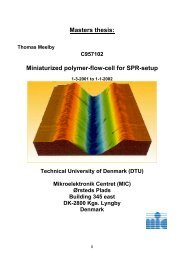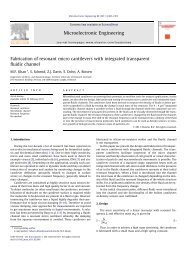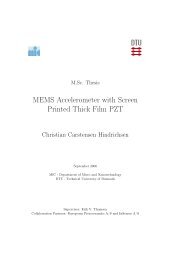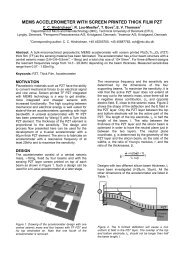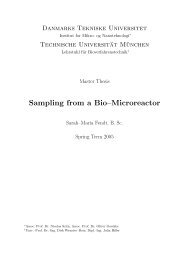Prototyping of microfluidic systems with integrated ... - DTU Nanotech
Prototyping of microfluidic systems with integrated ... - DTU Nanotech
Prototyping of microfluidic systems with integrated ... - DTU Nanotech
You also want an ePaper? Increase the reach of your titles
YUMPU automatically turns print PDFs into web optimized ePapers that Google loves.
3.2 Polymer types 25<br />
3.2.2 Elastomers<br />
As indicated by the name, elastomers are deformable, elastic polymers.<br />
The polymer chains are weakly crosslinked and can be stretched to high<br />
extensions. Subsequently, the structure can revert to its original shape<br />
because <strong>of</strong> the elasticity <strong>of</strong> the material.<br />
Poly(dimethylsiloxane)(PDMS) is by far the most commonly used<br />
elastomer in micr<strong>of</strong>luidics. In the crosslinked version, where a curing<br />
agent is added to a base, it has become popular for rapid prototyping<br />
<strong>of</strong> micr<strong>of</strong>luidic devices and as a stamp material for microcontact<br />
printing. Also, hot embossing using elastomer moulds has become a<br />
popular method, and has been named s<strong>of</strong>t embossing [21, 22]. PDMS is<br />
remarkable in that it can be cast against a mould to reproduce features<br />
smaller than 100 nm. The surface free energy is low, meaning that casts<br />
release easily from moulds. Furthermore, Young’s modulus is tunable,<br />
which has led to the development <strong>of</strong> valves and pumps in microdevices<br />
using reversible deformations. A standard grade PDMS like Sylgard<br />
184 from Dow Corning is temperature stable up to 250℃, and is optically<br />
transparent well into the ultraviolet range. Some PDMS types are<br />
resistant to temperatures up to 400℃.<br />
The surface properties <strong>of</strong> PDMS can be altered using oxygen plasma<br />
treatment, which makes the surface hydrophilic. This treatment also<br />
enhances the adhesion <strong>of</strong> the surface. PDMS adheres naturally to<br />
surfaces like glass, creating non-permanent bonds which can <strong>with</strong>stand<br />
lower pressures in e.g. micr<strong>of</strong>luidic channels, while irreversible bonds<br />
are created using plasma treatment.<br />
3.2.3 Thermosets<br />
Thermosetting plastics are polymers that are cured and thereby harden.<br />
The curing happens by adding energy through heat or irradiation, or<br />
by a chemical reactions (e.g. epoxy). This leads to cross-linking <strong>of</strong> the<br />
polymer chains by covalent bonds. These bonds will not break before<br />
the rest <strong>of</strong> the polymer chain, contrary to thermoplastics where the<br />
bonds between the chains break around the glass transition temperature,<br />
while the chains remain intact.<br />
In micr<strong>of</strong>luidics, the photoresist SU-8 is an example <strong>of</strong> a thermoset.<br />
Traditionally, it is used in silicon processing as a mask layer, where UV<br />
exposure through a mask crosslinks the SU-8 in the unmasked areas.<br />
The uncured areas are then removed, and the remaining crosslinked



